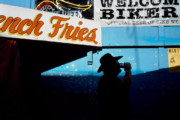Beyond the Silence: Territory
The first exhibition of the collaborative "Beyond the Silence" project opened on November 15, 2024 at the Egin Art Space in Almaty, Kazakhstan, and explores the concept of territory.
The collaborative project Beyond the Silence, launched earlier this year, seeks to create a dialogue between photographers from different countries to illuminate common experiences and challenges around the concepts of ongoing occupation and annexation, the impact of colonialism and censorship, and individual and collective choices to resist or adapt.
The first exhibition opened its doors to the public on November 15, 2024 at the Egin Art Space in Almaty, Kazakhstan, and explores the concept of territory.
The exhibition presents three separate projects: Magnum photographer Thomas Dworzak and his work along Kazakhstan’s northern border, Ukrainian photographer Mykhaylo Palinchak and a series of stories from people in recently liberated Ukrainian territories, and Kazakh photographer Yadykar Ibraimov’s project on the eastern border of Kazakhstan, focusing on Uyghur communities.
“More than land within legal borders, ‘territory’ is the space in which cultures, nations, and identities are formed and developed,” writes curator Kateryna Radchenko. “Over the past century, borders between nations have shifted countless times, and territories have become objects of political compromise, agreement, manipulation, and bribery.”
Thomas Dworzak
Like a Blood Stain on a Handkerchief
In 2022, Dworzak began documenting the second longest land border in the world — the northern part of Kazakhstan, along the Russian border. Dworzak explored the region’s multicultural and multinational identity, as well as the impact of colonial and Soviet history on its social and cultural fabric, mixing his images with screenshots from the widely consumed Russian pro-Kremlin and pro-Putin TV. Ordinary things and visual symbols from everyday life capture the connections between past and present, ideology and propaganda.
“I chose to travel along Kazakhstan’s Northern border with Russia,” Dworzak explains. “Starting in Astana, the new capital, which was moved further North, also in an attempt to balance the country, I wanted to look at the impact of colonial and Soviet history, its representation and current life among the significant Russian-Slavic population in the North and get a sense of their identity.”
Read Dworzak’s full essay, with contributions from writer Petr Trotsenko, here.
Mykhaylo Palinchak
Occupation Diaries
Ukrainian photographer Mykhaylo Palinchak‘s series Occupation Diaries aims to shed light on the realities of life under Russian occupation in different parts of Ukraine through a series of written testimonies and accompanying portraits. These are accounts of loss, abduction, physical and psychological torture, and death — memories that Ukrainians wish to forget as horrific nightmares, but which also serve as evidence of Russian aggression and brutality.
“In total, 109,000 square kilometers of Ukraine remains occupied, 18% of the country’s territory,” writes Palinchak. “We do not have accurate figures of how many people are currently living under occupation.”
“Occupation is like a black hole: a place where gravity is so intense that nothing can escape,” he continues. “It is silent, invisible. Only those who leave know what this ‘black hole’ really is. These stories tell us of the inability to imagine the next day, as well as the experience of loss, abduction, physical and psychological torture, and death. The memories are fragmentary and chaotic.”
Yadykar Ibraimov
Tono-naan is at home, but where is home?
Kazakh photographer Yadykar Ibraimov turns his lens on Kazakhstan’s eastern border and Uighur territory, documenting the experiences of Uyghur survivors of Chinese concentration camps. “Families torn apart, cultures wiped out, and lives changed forever. This is not some distant tragedy—it is happening right now to people with names, families, and dreams, many of whom are still suffering in silence,” he writes.
The project explores how the borderland has become more than a conflict zone; it has become a place of torture on one side and a sought-after refuge on the other — a political border that divides the landscape and threatens the fate of its people.
Many of the people in his images have fled brutal persecution, others are part of the Uyghur community in Kazakstan and have to live with the pain of knowing the forced, labor, torture and attempts to erase their people’s identities happening just across the border. “Their faces reveal the struggle to keep their traditions alive, the grief of displacement, and the deep longing for a home they may never return to. Here, in Kazakhstan, they’ve built new lives, but the weight of exile is ever-present,” Ibraimov writes.
Visit the first exhibition of the Beyond the Silence project at the Egin Art Space in Almaty, Kazakhstan, until December 8.
Five exhibitions will take place in different locations around the world over the next few months. The next exhibition will open on December 6 in Mexico, featuring the work of Rafał Milach.
Beyond the Silence is a collaborative project organized by Magnum Photos in partnership with Odesa Photo Days Festival (Ukraine), and with the support of the Open Society Foundations and Ukrainian Institute.
























